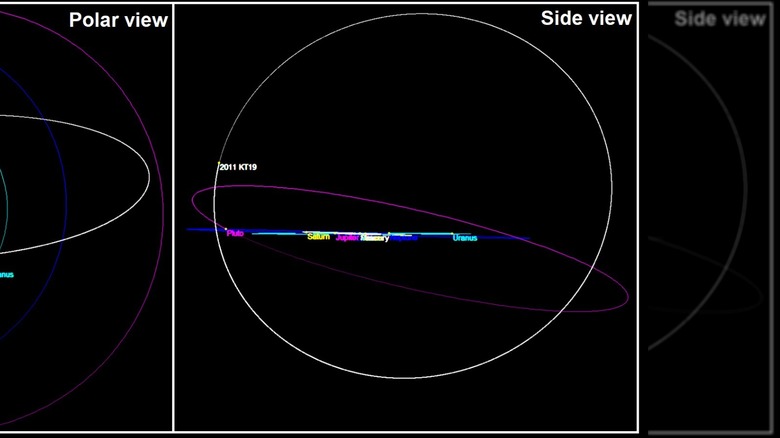Two Objects In Our Solar System That Orbit The Sun Backwards
Nearly everything in the Solar System orbits the Sun in a counterclockwise direction. There's a simple explanation for that. As most astrophysicists agree, the Sun, all eight planets, and the Solar System's many other rocky objects were formed from the same spinning cloud of gas some 4.5 billion years ago. As the gas cloud spun, clumps of matter gathered together due to gravity — eventually forming the massive Sun in the center and smaller objects to the extremes, as Space.com explains.
Since that gas cloud happened to be rotating counterclockwise, everything in today's Solar System rotates counterclockwise as well. Well, almost everything...
In the past two decades, astronomers have identified a few distant celestial objects that follow their own path — quite literally. Unlike the vast majority of planets and asteroids that orbit the Sun in the same flat, frisbee-like plane, these objects have very odd orbit angles that appear to shoot out from the rest of the solar system. Not only that, but the orbital angles of these objects are more clockwise than counterclockwise. In other words, these objects are like a few lone individuals trying to walk backward through a crowd of people pushing forward.
How this happened is a puzzle that astrophysicists are still trying to solve. Here, let's examine just two of these mysterious, backward-moving space objects.
A backwards-orbiting object nicknamed "Drac" was discovered in 2008
One of these rebellious space objects is (528219) 2008 KV42, nicknamed "Drac." Drac was first discovered in 2008, and first announced in a paper published in 2009. In that paper, the researchers identify Drac as "the first retrograde transneptunian object" — which, in plain English, means that Drac is the first known object farther than Neptune to orbit the Sun clockwise. (Neptune is used as a designator here because it's the farthest planet — sorry, Pluto!)
But to say that Drac orbits the Sun in the opposite direction than all the planets is a bit misleading. Drac actually orbits the Sun at a 104-degree angle — which puts its orbit nearly perpendicular to the orbits of the eight planets, yet slightly more clockwise than counterclockwise. This is pictured above; Drac's orbit clearly jets out from the plane occupied by the planets.
Drac is a medium-sized object; initial observations suggest it has a diameter of about 30 miles, per New Scientist. Also, its nickname is a playful homage to "Dracula"; Drac's nearly-perpendicular orbit reminded researchers of Count Dracula's ability to walk up walls.
How Drac got such an unusual orbit puzzled researchers at first. But, in the years that followed, the discovery of similar backward-traveling ,trans-Neptunian objects has begun to shed some light on the question.
"Niku," another distant object with a clockwise orbit, was discovered in 2016
In 2016, astronomers announced another backward-orbiting object: (471325) 2011 KT19, nicknamed "Niku." As Science Friday explains, Niku's orbit around the Sun is at a 110-degree angle; that's even more backward than Drac's 104-degree orbit. Niku is also larger than Drac, with a diameter of about 100 miles. And, like Drac, Niku's discoverers chose to give it a funny nickname: "Niku" means "rebellious" in Chinese.
Drac and Niku are just two out of a handful of clockwise-orbiting, trans-Neptunian objects that have been discovered in the past few decades. There are likely many more that remain undiscovered, given how small and distant these objects are.
But just how did these objects get their unusual backward orbits in the first place? Scientists are still scratching their heads about that but there are a few theories. The most interesting among these theories puts the blame on an undiscovered "Planet Nine." As National Geographic explains, astronomers have long suspected that there could be an undiscovered ninth planet with an orbit far past Neptune. This would help explain a number of unusual facts about the orbits of trans-Neptunian objects — including the backward motion we've described. Per Science Friday, some astronomers believe that Planet Nine's gravitational pull may be what knocked Drac, Niku, and other objects into their clockwise orbit. It's a far-out theory, but many researchers agree that it's worthy of further consideration.


